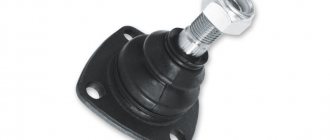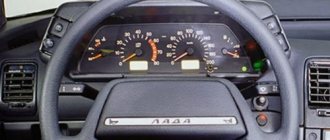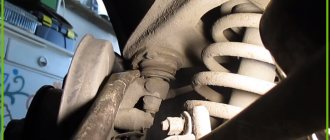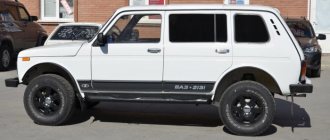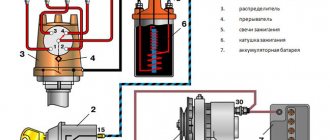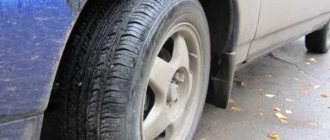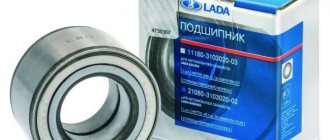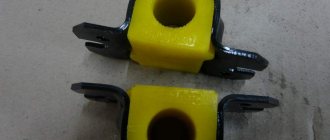09 February 2016 Lada.Online 208 398 81
The front and rear suspension of Vesta differs significantly from the one that AVTOVAZ used on Grant, Priora, Kalina, etc. All the reviews tell us that the new chassis design is better than before. However, during the first months of operation, the owners began to notice extraneous noises (knocks, creaks, rattles, crunches) in the front and rear suspensions of Vesta, which occur when driving over speed bumps or other road irregularities...
The most common shortcomings of the Lada Vesta car suspension
Drivers' complaints are caused by extraneous noises, squeaks and crunching sounds from the car's chassis. Most often they occur in the front part of the car, but many also complain about knocking from the rear suspension elements. The most common causes of these sounds are:
- Noise from front stabilizer struts.
Owners of the first Vesta cars began to notice extraneous sounds from the front suspension after several thousand kilometers. The reason for this turned out to be poor-quality stabilizer links. After considering consumer complaints, the manufacturer ordered that these parts be replaced free of charge in case of complaints.
- Rear shock absorbers knocking.
The rear struts knock when driving on rough roads. This is due to the fact that there is no insulating gasket between the shock absorber and the upper support, and metal hits metal when hitting an obstacle. The official service does not undertake to eliminate this deficiency, since it does not affect the driving performance of the car.
Features of the suspension on LADA Vesta
Even at the stages of car development, it was known that the Vesta platform would be truly new, and not just another modernization of the VAZ 2108 suspension. Now that serial production of the sedan has already started, and the first samples have already been on test drives in various car magazines, more detailed details are being clarified about the chassis of the Lada Vesta.
The last adjustments to the suspension characteristics took place in winter in Spain, at the IDIADA training ground. Then a balance was found between comfort and car controllability. What happened?
The Spanish testing ground IDIADA was chosen for the final configuration of the car parameters. The manufacturer's goal was to achieve the greatest possible interaction between the driver and the vehicle, and he really succeeded:
- the car moves confidently in a straight direction, while the driver accurately feels when the steering wheel is in the zero position;
- when cornering on uneven sections of the track, the steering wheel does not vibrate, and this guarantees constant feedback between the driver and the car;
- accelerating the car while entering a turn, the driver does not feel shaking;
- The new Lada model has a suspension that provides for the use of electronic systems - EBD, ABS and ESP. Thanks to the built-in stabilization system, control during a skid or drift is facilitated; the driver has full control of traction;
- The versatile Vesta has excellent cross-country ability, on the one hand, thanks to the correct suspension settings, and on the other, due to high-quality electronics. In order to overcome off-road areas, the manufacturer installed an imitation of differential locks - a new product for AVTOVAZ, which the owners have already noted as an improvement.
Suspension features
Unfortunately, many cars produced by AVTOVAZ have problems with the chassis. The new Station Wagon models have a redesigned and improved suspension, mainly focusing on the front part of the part. The car boasts L-shaped levers. To create them, high-quality steel, a high-strength body and a subframe were used.
How to identify the cause of the noise yourself?
If the machine is under warranty, if you suspect any malfunction, you must contact your nearest service center. If the warranty has expired or this is not possible, you can try to determine the cause of the unpleasant noise yourself.
To do this, you need to hang the car wheels and move them in different directions. When conducting diagnostics, the following conclusions can be drawn:
- If there is play when the brake pedal is not pressed, then the wheel bearing needs to be replaced;
- If there is something wrong with the suspension, the play will not go away when you press the brake pedal;
- A ball joint defect can be suspected if the play occurs in the vertical plane. This sensation can also occur if the stand is poorly secured;
- Wobbling in the horizontal plane most often indicates a faulty tie rod end.
Having identified the causes of a creaking or rattling noise, it is necessary to eliminate it as soon as possible by replacing damaged parts. It is better to do this at a service station, where specialists will carry out reliable diagnostics and carry out repair work.
How to understand that the calipers are knocking
The brake line begins with a pedal inside the car and ends with a pair of discs and pads. The driver’s force, when he presses the brake, is transmitted through a complex system, the penultimate link of which is the caliper on Vesta.
Spring from the “classic”. Photo source: https://lada-vesta.info/694-stuk-supportov-lada-vesta.html
The part performs important functions:
- Presses the pads against the brake disc when the pedal is depressed.
- Fixes the pads at a distance from the disc when there is no force on the brake.
- Keeps the pads strictly parallel to each other and the disc - when misaligned, the braking surfaces quickly wear out and braking deteriorates.
The calipers on the Lada Vesta must work smoothly and be technically flawless. But at twenty thousand kilometers, when the car is still under warranty, an extraneous sound from the brake system appears from under the bottom. At dealerships, the issue is not resolved, citing the design features of the unit and the permissible noise level.
Drivers themselves have to get rid of the problem. But first you need to find out whether it’s the calipers on Vesta that are really knocking, and not the valves or other engine elements. To find the irritant, expensive diagnostics are not needed.
Front suspension. What might be a concern?
- Wheel bearings.
Wheel bearing noise can be detected by ear even by a less experienced driver. It howls and rustles when moving and, gradually increasing, begins to drown out all other noises in the cabin. To make sure that it is the bearing that is making noise, you need to turn the steering wheel a little when driving at speeds above 60 km/h. If the rumble appears in one steering position and stops in another, it means the bearing has definitely failed. You can also check this by lifting the car wheel and spinning it. If you hear a characteristic rustling sound, it means the bearing needs to be replaced.
- Stabilizer's pole.
Stabilizer links are the most vulnerable part of the suspension. Due to the poor quality of roads, they often fail and begin to produce a slight but constant noise from under the bottom of the car. You can determine if the struts are broken by resting the lever on the subframe and shaking the stabilizer. If during these actions a knock is heard and play is felt, it means that the stabilizer links are out of order.
These parts are usually replaced in pairs, and you can do it yourself. To do this, you need to hang the front wheels of the car, and using a 16 wrench, unscrew the hinge nuts, while holding them with a 5 hex wrench on the back side so that the hinges do not turn.
- Spherical bearing
The sound of a broken ball joint can be difficult to distinguish from other suspension noises. You can check the play of this unit by moving the suspended wheel in a horizontal plane. If the fault cannot be determined, you can insert a pry bar between the subframe and the lever and press on the resulting stop. This is the easiest way to identify a loose ball pore.
At the service center, the ball joint is replaced along with the lever and silent blocks. But these parts also exist for sale as a separate unit.
Replacing a ball is not an easy operation, so you can tackle it yourself only if you have the necessary tools and metalworking skills.
- Shock absorber.
Many drivers complain about the knocking of Lada Vesta shock absorbers, but their design itself eliminates this possibility. The telescopic strut consists of two cylinders that dampen vibrations while moving on uneven roads. When they break down, the car begins to “sit down”, the road holding is poor, all the unevenness and bumps become clearly noticeable, and the steering deteriorates. In this case, the outflow of liquid or gas from one cylinder to another is disrupted, and the shock absorber rod begins to make characteristic sounds that resemble knocking.
Visually, a breakdown of the oil shock absorber can be determined by drips on the casing, in the presence of which the part must be replaced immediately. You can also rock the car, focusing on the hood. Under normal conditions, after the impact ceases, the machine should swing once and stop moving. If this does not happen, the racks do not absorb as expected.
- Upper rack support
The upper mount of the front shock absorber contains a support bearing that can knock and howl when driving. You can identify a malfunction of this unit in the following way: swing the car in a vertical plane and put your hand on the support. If a part malfunctions, rattling and humming will be felt.
Another method requires completely dismantling the rack. This check can be done simultaneously with replacing the front shock absorbers. After removing the steering knuckle, you need to rotate the strut together with the spring in a circle. The crunching and grinding sound in the upper part of the assembly that occurs during this indicates that the support is faulty.
Like shock absorbers, it is advisable to change the upper supports at the station, since the process of dismantling and installing them is quite complicated.
Independent work
In this case, there are several ways:
- Bushing lubrication;
- Replacement with analogues.
Bushing lubrication
If you choose this option, everything is done exactly the same as when contacting a dealership. However, car owners choose the lubricant themselves. Some people buy regular mastic, others use foreign lubricants, for example, Japanese ones.
Owners buy different lubricants
Be that as it may, these are only temporary measures, since mastic and other lubricants are still quickly washed out. It may last a little longer, but that doesn't solve the problem.
Replacement with analogues
According to reviews from owners, most often either bushings from Chevrolet Niva or components from KIA are used.
Bushings from Chevrolet Niva
Elements from this model are suitable for Lada Vesta, which can be bought at almost any car store. In addition, they can be ordered online using the following article numbers:
Stabilizer bushings from Chevrolet Niva
The second type of product has larger dimensions, so it is used more often. The price of bushings from Chevrolet Niva is about 150 rubles per pair. However, there are also polyurethane products on sale, which are often painted in bright colors (yellow, red, etc.). The price of polyurethane products reaches 250 rubles per piece.
You can purchase products from one of the resources below:
- https://www.autopiter.ru/goods/21232906046/rossiya/ >However, Vest owners note that elements from the Chevy Niva also often creak, and it doesn’t make much difference what material they are made of - rubber or polyurethane.
Bushings from KIA
These are more expensive components, which can be purchased under article number KSBSOULF or 54813-2K100. The price for such products is significantly higher than for similar ones from ChevyNiva. Usually the cost varies between 400-650 rubles, but the price can reach 850 rubles per piece. Therefore, it is recommended to monitor offers from various suppliers before purchasing. In this case, you need to buy only original products. Purchasing a non-original one is fraught with the same creaking noise, which is extremely unpleasant, because bushings from a Korean manufacturer are not cheap.
You can purchase them on one of the following sites:
- https://koreanaparts.ru/product/548132K100/730
- https://www.autodoc.ru/part/hyundai-kia—647/548132k100/
- https://www.autopiter.ru/goods/548132k100/hyundai-kia/id11105217
- https://plentycar.ru/autopart/1981834
In addition, it is worth taking into account the configuration of parts from HYUNDAI-KIA, which differs significantly from that of the Lada Vesta. For this reason, along with the bushings, you need to buy brackets for them, which are sold under article number 54814-1G000. The price tag for them ranges from 300 to 500 rubles per piece.
Comparison of Russian and Korean elements
You can order brackets online at the following addresses:
- https://koreanaparts.ru/product/548141G000/730
- https://nomer52.ru/kronshtejn-vtulki-stabilizatora_hyundai_elantra-hd_548141g000_mobis_i126/
- https://www.autodoc.ru/part/hyundai-kia—647/548141g000/
- https://www.autopiter.ru/goods/548141g000/hyundai-kia/ >
Bracket for bushings from Kia
Rear suspension knocking and noise
Unpleasant knocks from the rear suspension occur less often than from the front, but sometimes they also bother owners of Vesta cars.
The most common phenomena that can cause noise are:
- Rear beam silent blocks;
- Faulty rear shock absorber mounts or shock absorbers themselves;
- Lack of soundproofing gasket between the shock absorber and the upper support.
The first two problems are eliminated by replacing failed components. The knock of the strut on the support does not affect the driving performance and is not a breakdown, but a factory defect of Vesta. You can eliminate it by placing a purchased or self-made gasket between the parts that are closing and emitting an irritating sound.
Problems with noise and squeaking from the rear of the car
The front suspension is designed reliably, similar to foreign brands, taking into account long-term use.
Quite often, extraneous squeaks are caused by brake calipers.
There are isolated cases where the following types of breakdowns have occurred over time:
- The silent blocks of the steering gear levers require replacement, which are extremely inconvenient to remove.
- Brake calipers may gradually begin to click, replacing the pins may solve this problem.
- A small play appears in the place where the strut cups are attached to the body, associated with wear on the threads of the mounting bolts.
Poorly spun wheels can crunch and squeak. This often occurs on other car models and is caused by the car owner’s carelessness when changing wheels. It is urgent to stop and tighten the wheels.
Poorly packed items in the trunk of a car can make knocking and crunching noises. Before trying to eliminate suspension squeaks, you should empty the trunk of all unnecessary things and drive the car.
If there are no extraneous sounds, then the issue is resolved. Sources of extraneous noise from behind can also be minor problems, but to eliminate them you need to know them:
- The handbrake cable is not secured, just tighten the tie;
- The trunk lid dampers may make different sounds; they should be lubricated with silicone grease;
- With increased play, the trunk lid begins to rattle; lubricate and eliminate the play;
- The locks of the rear seat back may squeak, just lubricate and wrap a little electrical tape;
- Things are poorly packed in the trunk.
The front and rear suspension of Vesta differs significantly from the one that AvtoVAZ used on Grant, Priora, Kalina, etc. All the reviews tell us that the new chassis design is better than before. However, during the first months of operation, the owners began to notice extraneous noises (knocks, creaks, rattles, crunches) in the Vesta’s front and rear suspensions, which occur when driving over speed bumps or other road irregularities.
A dull sound, as if the racks are touching the plastic, or a creaking sound reminiscent of rubber friction. The reason is the poor quality of the stabilizer bushings (No. 8) or insufficient lubrication of the muffler mounts.
It is enough to lubricate the gingerbreads (muffler mounts) with grease. There is no point in lubricating the rubber bushings of the stabilizer, because... this doesn't last long. You can solve the problem of front suspension squeaking like this:
- replace the standard stabilizer bushings with polyurethane ones (catalog number: 17012680).
- install analogue bushings.
- place a piece of rubber under the bushings (see video below).
- Since February, AvtoVAZ has been replacing the old-style stabilizer bar with a new one under warranty.
Question to AvtoVAZ: When will the problem of squeaking bushings be resolved? New cars from October-November continue to creak.
Answer: Improvements were introduced (replacement of rubber, lubricant) at the end of November 2016.
Although the suspension turned out to be successful, malfunctions periodically arise, which the manufacturer analyzes and makes recommendations for eliminating squeaks in the Lada Vesta. They may appear as extraneous sounds or knocks.
Creaking from behind the car
Malfunctions can also manifest themselves as a knocking sound in the rear suspension when driving over uneven surfaces or a creaking noise from the rear. All these sounds signal a problem that needs to be solved. In order to remove it, as recommended by the factory, it is necessary to cut out the gasket and install it on the upper shock absorber support. This will eliminate knocking in the Lada Vesta suspension.
A dull sound, as if the racks are touching the plastic, or a creaking sound reminiscent of rubber friction. The reason is the poor quality of the stabilizer bushings (No. 8) or insufficient lubrication of the muffler mounts.
Question to AvtoVAZ: When will the problem of squeaking bushings be resolved? New cars from October-November continue to creak.
Owner reviews about the Lada Vesta suspension
| Positive | Negative |
| The rubber blocks in the suspension squeaked in the rain from the very first day of purchase. I didn't pay attention when during the maintenance they asked if any suspension sounds were bothering me. I voiced my problem and they replaced my stabilizer bars for free. | I think the car is not worth the money. I chose between Polo, Solaris and Vesta. I took Vesta because it was cheaper, and the quality, as it seemed to me during the test drive, was the same. But, unfortunately, this is not the case. I was disappointed after the first 10 thousand mileage. The automatic transmission works terribly and the suspension rattles like an old Lada. |
| I have owned a Vesta SV Cross car for about a year now. I took it in a minimal configuration, but I’m happy with everything. The cross-country ability is really good, even on our broken country roads. The suspension doesn't make itself felt at all, I haven't changed anything in all this time, and nothing creaks. | In addition to the creaks of the interior and peeling chrome on the decorative elements, the suspension was terribly disappointing. The defective stabilizers were replaced under warranty. But after a while they began to creak again. The rear shock absorbers also make a lot of noise. And in general, the whole suspension is kind of flimsy, as if you were driving a Chinese car! |
| I drove about 3000 km on my Vesta. I go mainly to the dacha and fishing, so the load is almost always full. The suspension behaves decently, at least I didn’t notice any knocks, and during the technical inspection they said everything was fine. | 3 months after the purchase the front began to rattle. And soon the rear shock absorbers. I went to the service several times - they didn’t care about my problems! In the end they agreed to change the racks, but they were not in stock. I'm waiting for the third week, I'm already tired of visiting them! I don’t recommend buying Vesta at all, it’s better to take Rio and not know grief! |
| Overall I like the car. Beautiful, comfortable, roomy and most importantly - inexpensive. What worries me a little is that the steering wheel doesn't respond well when turning at high speeds. This is probably due to the high ground clearance. There are no comments on the suspension, it works properly, no noise was noticed. | In addition to the fact that the front windows were quickly scratched by poor-quality seals, after six months of use on the Vesta, clear knocking noises from the rear suspension began to be heard. It turns out that eliminating noise is not the responsibility of the warranty service, so I had to finish it myself. I bought special fluoroplastic spacers on the market. Installing them is not difficult, but why waste time, especially since the car is completely new? |
Review of Manufacturer Prices
| Catalog number / Size / Diameter | Price in rubles |
| Original | |
| 17012680 (inner diameter 21.5 mm.) | From 400 |
| 8450006748 | From 400 |
| Analogs | |
| Polyurethane from Chevrolet Niva 2123 (17012680) | From 350 |
| Polyurethane for Lada Vesta from Kia Rio (548132K100, 548141G000) | From 550 |
| 54813-2K100 (diameter 21.5 mm.) | From 550 – 600 |
| KSBSOULF (diameter 21.5mm) – new sample | From 550 – 600 |
| Vesta front left / right (8450006750), stabilizer struts length 275 mm | From 700 |
| RENAULT Logan suspension mount (30768) | From 130 |
| Nut RENAULT 7703034221 | From 300 |
| Bracket 8450006747 | From 350 |
| Rod 8450006748 | From 450 |
| Toyota Rav4 (48820-42020), length 285 mm | From 2500 |
| CTR (CLT50) | From 650 / piece |
| Renault, SASIC, SIDEM, LEMFORDER, length 275 mm | From 400 |
| Alfa – Fiat – Lancia 46413122 | From 370 |
| MONROE: L15600 | From 380 |
| Multipla, Lybra | From 350 |
| Kia Rio (548132K100) | From 370 |
| Bracket (548141G000) | From 250 |
*prices are as of April 2, 2019.
Conclusion
If you notice a third-party creaking, knocking, or rattling noise in the suspension, don’t panic. Malfunctions are a natural process
At the initial stage, it is important to correctly identify the source of the breakdown and its location
If you do not have a special tool, such as mounting tools or TORX keys, contact a service station. It is extremely difficult to repair a car with your bare hands.
Regarding the manufacturer of spare parts, the final decision rests with the owner of the technical equipment. The domestic manufacturer is not inferior in quality to foreign analogues. In this case, it is not advisable to overpay for the brand.
Conclusion
- The suspension of the Lada Vesta car is of good quality, but has some shortcomings.
- One of the most common reasons for contacting warranty service is knocking and noise from the front and rear suspension.
- Most often, the front stabilizers fail, as well as the rear shock absorbers, which begin to work noisily over time.
- It is possible to make a diagnosis yourself, but the result will not always be unambiguous. If this is possible, it is better to contact a service station to professionally diagnose and, if necessary, repair the car.
Detected malfunctions in the suspension
Even during the release of the first batches of Vesta from the assembly line, buyers rightly noticed shortcomings in its work, which were corrected in subsequent batches. The sounds that the rear or front suspension can make are very varied - the design is very complex, consisting of many parts that can fail. However, the most common breakdowns among Lada Vesta owners stand out and are worth disassembling.
Creaking, crunching, knocking from the rear suspension of the Lada Vesta
Rear crunching is a fairly old problem for West. The knock of the rear chassis is corrected according to a special instruction from AvtoVAZ, according to which the design will have to be slightly supplemented. Between the upper support and the rear shock absorber strut you need to place a washer with a length of 130 mm, a distance between the holes of 100 mm (hole radii - 5 mm), a base radius of 34 mm, and finally a radius of the main hole of 25 mm.
The crunch will disappear, but only if the washer matches the dimensions, otherwise a gap will appear between the body and the support, into which dirt gets trapped. The cause of concern due to crunching or knocking may also be:
- worn trunk lid damper;
- stretched handbrake cable (it can be pulled from the passenger compartment);
- trunk lock;
- rear sofa backrest fasteners.
And just in case, check the contents of the trunk itself - there may just be tools rattling around there.
Bumping knocks and noises in the front suspension of Lada Vesta
- The first, most popular reason for calling for service is the thumping (knocking) sound of the front suspension of the Lada Vesta, which comes from the stabilizer. Typically occurs when driving over artificial bumps. Stabilizer bushings, unfortunately, are not suitable for long-term use; even lubricant will not help - the only way to treat them is by replacing them. To solve the problem, you can install polyurethane bushings from Niva Chevrolet, its number is 17-012-680.
- The second reason for knocking can be called play of the ball joint, when a large gap is created between the parts. Problems can be solved by changing the design with levers. A grinding noise can be heard due to wear on the stabilizer struts and can mean that the car is gradually “losing” confidence when cornering.
- The creaking of the front suspension is caused by the hinges of the stabilizer struts. While driving, a knocking noise may occur due to insufficient tightening of the wheel bolts. When such a sound is heard, it is better to contact a service station as quickly as possible to prevent parts from breaking.
- The reason why the suspension on the Lada Vesta rattles and creaks can be heard may be that one of the parts has worn down to a sufficient level and is now knocking against another. To notice damage in time, it is enough to periodically inspect your car. If something is rattling, the part can be identified by shaking the car.
- If crunching or knocking noises in the front suspension are heard infrequently, the cause most likely may be a torn steering rod oil seal. This oil seal is in very close contact with the subframe of the vehicle (the distance between them at rest is 1 cm), and they collide at every bump. The oil seal breaks, and the connection of the rod to the rack hits the subframe.
Steering linkage and steering gear
This system has many joints, any of them can knock:
- steering tips, these include everything said above about ball joints, the design is identical;
- ball joints of steering rods in conjunction with the rack and pinion steering mechanism, usually these parts can be replaced separately from the ends;
- guide bushings at the exit from the rack housing; the rack will need to be rebuilt and the repair kit replaced;
- connecting the steering shaft drive gear to the rack; sometimes it is possible to tighten and adjust the gap;
- the gap between the worm and the sector in the worm steering mechanism is eliminated by adjustment.
The steering column may also knock, but this sound is quite easily localized and is not disguised as knocking in the suspension.
Wear of stabilizer bushings
If, when driving over a speed bump, a dull knock or squeak is heard from the front, there is a high probability that the reason for this is premature wear, due to the poor quality of the material, of the standard anti-roll bar bushings of the Lada Vesta - a malfunction typical of the VAZ sedan. In this case, other signs corresponding to the assumption should be present:
- knocking of the chassis when the car rolls while moving;
- beating in the steering wheel when driving on a flat surface at speeds above 60 km/h;
- increased play in the steering mechanism during intensive maneuvering;
- involuntary deviation of the car from straight-line movement.
The final conclusion will be made by inspecting the car on a car lift - if the bushings are swollen, have lost their geometry and elasticity, then they need to be replaced.
Replacing anti-roll bar bushings
If the dealer service center is remote and standard spare parts are available (catalog number: 8450006748), you can do this work yourself, with minimal risk of subsequent detection of independent intervention. After the warranty period has expired, or at the dealer, it is better to replace these parts with higher quality analogues, for example, polyurethane bushings from Lada Chevrolet Niva (article No. 17012680) or products from other manufacturers according to the dimensions indicated in the pictures.
To do the job you will need the following tool:
- TORX 40 angle wrench;
- ring wrenches “13” and “16”;
- 10" head with extension and wrench.
The bushings are replaced on an overpass, inspection pit or car lift. It is not allowed to change parts by jacking up the front axle shafts one by one.
Work order:
- Using a 10mm socket with an extension, remove the protective cover of the steering mechanism;
- Using a 13mm spanner, remove the two rear bolts securing the steel brackets of the bushings;
- Using a T40 wrench, unscrew the front bolt securing one of the two brackets and remove the bracket;
- remove the old bushing from the stabilizer, clean and lubricate the hole in it with silicone grease, install a new bushing through the cut on it and first fix the steel bracket with the front bolt;
- replace the second bushing in the same way;
- tighten the 4 bracket fastening bolts with a force of 2.0-2.4 kgf m;
- Install the steering gear protective cover.
Polyurethane bushings have a service life that is 2-4 times greater than the potential of rubber products.
Reviews
| № | Positive |
| 1. | Stepan Vasilyevich , 42 years old (otzovik.com): the suspension is mounted on a subframe, the levers and steering knuckles are of a new shape. Obstacles on the road are overcome smoothly, without impacts. |
| 2. | Gennady Semenovich , 39 years old (www.zr.ru): at speeds up to 125 km/h the suspension works as comfortably as possible. The problems start from above. |
| 3. | Timofey , 22 years old (autobann.su): pleased that gas shock absorbers are installed by default. This is just right for the urban cycle. |
| 4. | Kirill , 33 years old (lada-vesta.net): before the Lada Vesta I had a Granta, it has an old type suspension design. Vesta uses frame technology. The steering rack and stabilizers are fixed to the beam. |
| 5. | Semyon Nikolaevich , 44 years old (otzovik.com): my positive review of the chassis and suspension of the Lada Vesta. The car is in its second year - no complaints, minor bumps are absorbed silently. |
| 6. | Lev Nikolaevich , 45 years old (www.zr.ru): I live in a rural area, you know what the roads are. The suspension works great. My recommendations to motorists. |
| 7. | Dmitry , 20 years old (autobann.su): springs are installed separately from shock absorbers, semi-independent type with a number of improvements that were so lacking in previous generations. |
| 8. | Mikhail Gennadievich , 43 years old (lada-vesta.net): the angle of inclination of the front pillars is 5 °, which has a positive effect on the handling characteristics of the car. The steering from the second generation Renault Megane is better than its domestic counterpart. |
| 9. | Kirill , 40 years old (otzovik.com): good car, good build, no comments on the chassis or transmission. |
| 10. | Petr Semenovich , 42 years old (www.zr.ru): the car is three years old, there are no comments on the components, I systematically carry out technical inspections and diagnostics, and treat the equipment with care. |
| 11. | Alexander , 35 years old (autobann.su): during two years of active operation of the car, I replaced the rubber bushings on the stabilizers once. I am satisfied with the build quality of the domestic car. |
| Negative | |
| 12. | Konstantin Stanislavovich , 43 years old (www.zr.ru): the chassis has not lasted even two years, it thumps, the suspension creaks in the cold. The officials said that this is not a warranty case and they cannot help. I replaced the rubber bands myself with polyurethane ones. |
| 13. | Vitaly , 27 years old (otzovik.com): instead of standard rubber bands, I installed polyurethane ones from Chevrolet Niva. The service life of the last 60 - 70 thousand km. As it turned out, the reason for the knocking was premature wear of the rubber seals of the stabilizer link. |
| 14. | Grigory Vladislavovich , 45 years old (autobann.su): a model with obvious defects, after purchase it needs a comprehensive re-upholstery of components, mechanisms, and partial noise reduction. |
Is the suspension knocking - check the steering
- wear of the steering rack tips. This problem usually occurs when driving on small bumps and gravel roads. In addition, a knock occurs when the steering wheel begins to rotate left or right, and there is slight play in the steering wheel. The problem can only be solved by replacing the tips;
- gap between gear and rack. Such a malfunction may be accompanied by vibration in the steering wheel. If the parts are not worn out much, you can correct the situation by tightening the steering rack to the gear;
- wear of steering rod bushings. Diagnostics is carried out using a pry bar, with its help you need to shake the levers in different directions, which will allow you to determine the play. The problem is eliminated by replacing the rubber bushings. The photo below shows the dismantling of the steering rod on a Ford Focus 2.
Support bearing knock
Often, car enthusiasts perceive the shock of the shock absorber rod as the knock of the wheel bearing. This can be explained by the design of the rack: two cylinders and a metal rod.
During systematic use, the bypass valves wear out and the strut does not dampen vibrations. With a sharp push, a blow occurs, which is perceived as a knock of the support bearing.
To guarantee that the latter is faulty, it is necessary to conduct a comprehensive diagnosis. It’s not difficult to do this yourself; in the transport position of the car, it’s enough to bleed the strut with a few presses on the car’s fender. After sharp pressure, the car must stabilize on its own, otherwise the shock absorber strut is faulty.
If there are no complaints about the shock absorber, then you are guaranteed to replace the support joint. The process is quite complex and requires minimal knowledge in servicing equipment. Unprofessional intervention does not guarantee full functionality of the mechanisms.
In order to carry out comprehensive diagnostics and replace worn-out equipment, contact a certified service station for help.




